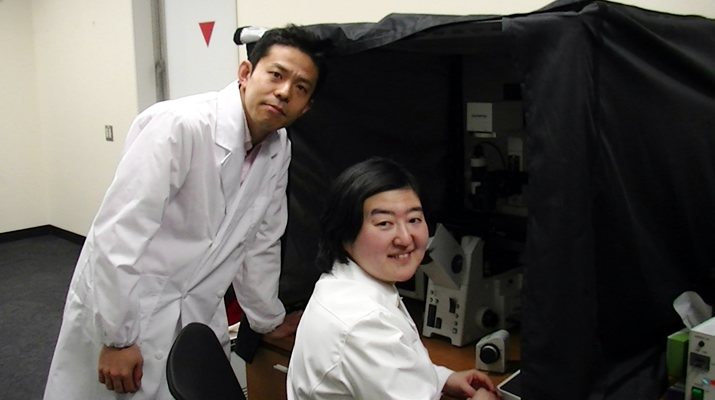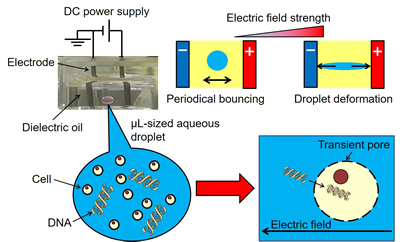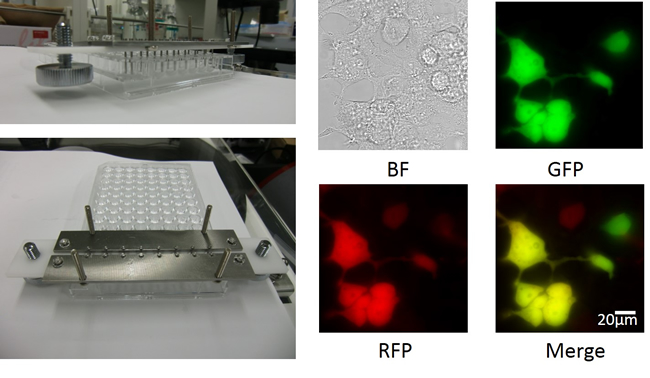
ここからコンテンツです。

Innovative method for delivering genes into cells
Electroporation of cells using electrostatic manipulation in a water-in-oil dropletBy Rika Numano
Rika Numano and her colleagues developed a novel transfection method using water-in-oil droplet electroporation: a liquid droplet with exogenous DNA and cells that is suspended between electrodes in dielectric oil is exposed to a DC electric field. This method enables high-throughput screening and may contribute to the development of cell transfection in regenerative medicine and gene therapy.
Living cells express genes involved in physiological functions like development and metabolism via complex mechanisms. The cell membrane protects the genome from various exogenous molecules. Cell transfection is a fundamental technique that is used to deliver molecules, such as nucleic acids, proteins, and drugs, into living cells. The technique has been implicated in the development of a broad spectrum of life science applications.
Electroporation is a popular technique for the delivery of cell-impermeable molecules into cells through transient pores in the cell membrane, which are formed by exposing cells to electric pulses. However, most commercial electroporation-based transfection methods require the use of specialized pulse generators to produce short electrical pulses at high voltage.

Now, Rika Numano and her colleagues at the Department of Environmental and Life Sciences and the Electronics-Inspired Interdisciplinary Research Institute (EIIRIS) of Toyohashi University of Technology, have developed a novel gene-transfection method: water-in-oil (W/O) droplet electroporation with sufficient transfection efficiency and cell viability. In this method, when a liquid droplet suspended between a pair of electrodes in dielectric oil is exposed to a direct current (DC) electric field, the droplet moves between the pair of electrodes periodically and deforms under the intense DC electric field (Figure. 1).

" Water-in-oil droplet electroporation is operated using a DC power supply, which obviates the need for an expensive pulse generator. In addition, the size of the droplet is quite small compared with that in conventional bulk electroporation, resulting in the use of fewer materials in high-throughput analysis", explained Assistant Professor Hirofumi Kurita and Professor Akio Mizuno.
“The water-in-oil droplet electroporation technique has several advantages over conventional transfection techniques: the small cell number required, as low as 1000 cells; the small amount of DNA required, which makes it applicable for various cell types including neural cells; and the changeable genome DNA. There have been improvements in W/O-droplet electroporation electrodes for use in disposable 96-well plates for concurrent performance (Fig. 2). This technique can contribute to further biomedical innovation in high-throughput screening with a large number of samples for applications in regenerative medicine and gene therapy", explains Rika Numano.
This study was supported by
- MEXT/JSPS KAKENHI Grant Numbers 4590350, 24108005, 24760648, 26390096
- MEXT Supporting Activities for Female Researchers (partnership category)
- TAKEDA Scientific Foundation, TATEMATSU Foundation, Napa Gene Col, Ltd.
Reference
Hirofumi Kurita, Shota Takahashi, Atsushi Asada, Minako Matsuo, Kenta Kishikawa, Akira Mizuno, and Rika Numano (2015). Novel Parallelized Electroporation by Electrostatic Manipulation of a Water-in-oil Droplet as a Microreactor: PLOS ONE: 10.1371/journal.pone.0144254
細胞への遺伝子導入の革新的手法「液滴エレクトロポレーション」の開発
細胞と外来性DNAを封入した油中の水滴に電界をかけて、細胞にDNAを導入沼野利佳准教授らの研究グループは、液滴エレクトロポレーションという、革新的な細胞への遺伝子導入法を開発しました。細胞と外来性DNAを封入した液滴に直流電界を印加すると、絶縁体の油中で電極間を液滴が往復運動し、短絡現象が生じる間にDNAが細胞に導入され、細胞の生理機能が変化します。この技術は、使用する細胞やDNA量を大幅に削減可能であり、ハイスループットのスクリーニングが可能となり、医学に革新をもたらすことができるものです。
細胞の発生運命や多様な機能は、ゲノムの中でどの遺伝子がどういう順番で、どのくらい働くかで決まります。細胞には、こうした精妙な仕組みがあり、多数の遺伝子を外から導入すると、細胞の運命や機能を変えることができます。しかし、細胞もこうした、外部撹乱から身を守るために、簡単には外来性の遺伝子を導入しないよう、細胞膜で独自の遺伝情報を守っています。
細胞に高電圧をごく短時間印加することにより、細胞膜に可逆的に細孔を開け、遺伝子、タンパク質、薬剤などを細胞内に導入するエレクトロポレーションという方法がありますが、市販のエレクトロポレーション装置は、高い電圧の電気パルスを発生する高価な特殊パルスジェネレーターを必要とします。
環境生命工学系の栗田弘史助教と環境生命工学系・エレクトロニクス先端融合研究所(EIIRIS)の沼野利佳准教授は、十分な細胞生存率と遺伝子導入効率を示す遺伝子導入法である液滴エレクトロポレーションの開発に成功しました。まず、細胞と導入したいDNAを絶縁体であるオイルの中の数マイクロリットルのごく少量の水滴に封入し、ここに直流電界を印加します。電界中の液滴はクーロン力によって電極間で往復運動したり、より高い電圧を印加することで変形したりします(Figure 1)。この間に、細胞に瞬間的に電気パルスを印加することで、細胞膜に細孔を開けて複数種の遺伝子を導入でき、細胞の生理機能を変化させることができます。
環境生命工学系の栗田弘史助教と水野彰教授は、「本法は、直流電源による処理のため、高価なパルスジェネレーターが必要ない。また、数マイクロリットルの油中水滴を処理容器として用いるため、従来のエレクトロポレーションと比較して、試料となる細胞、導入DNA量を大きく削減できる。」と説明します。
沼野利佳准教授は、「本法で、1000個単位のそれほど多数でない多様な細胞に対し、多種類のDNAが導入可能であり、並列処理によるハイスループットのスクリーニングによって医学に革新をもたらすことができる。今まで遺伝子導入が困難であるとされてきた神経細胞やゲノムDNAの改変も可能で、再生医療と遺伝子治療のための遺伝子導入を大いに発展させるものである。」と説明します。
本研究は以下の助成を受けて行われました。
- 科学研究費助成事業(4590350, 24108005, 24760648, 26390096)
- 文部科学省「女性研究者研究活動支援事業(連携型)」
- 武田科学振興財団、立松公益財団、ネッパジーン株式会社
Researcher Profile

| Name | Rika Numano |
|---|---|
| Affiliation | Department of Environmental and Life Sciences |
| Title | Associate Professor |
| Fields of Research | chronobiology, molecular biology, neuroscience |
ここでコンテンツ終わりです。
